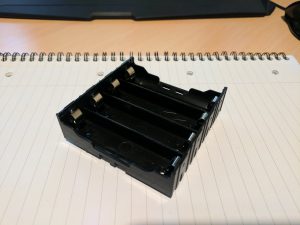18650 Power Wall
The next step in my solar power quest is to get a decent amount of storage. To that end, I’m attempting to make my own 18650 power wall using all the recycled cells I’ve been harvesting.
Power Wall Design
I’ve been watching a lot of DIY power wall projects, including HBPowerwall and Jehu Garcia. Unlike my batteries for R2 which will be charged and discharged with me present, a power wall needs to be left unattended for extended periods of time usually. Mine will be in the garage and I’ll only be physically present when working on projects in there. This means that I need to add some extra safety features into it such as fuses.
Fuses and holders

4 x 18650 Holder
A lot of people have been soldering fuse wire directly to the 18650 cells, but this is something I want to avoid. Firstly, this runs the risk of ruining the cell. Secondly, I’d like to easily be able to swap out failed fuses and cells. One person I’ve been watching on YouTube is Adam Welch who had a nice idea on how to solve both these issues. I’m extending on his idea by using fuse holders and standard 5x20mm fuses. Along with this I will be using some standard PCB mount 4 x 18650 holders.
The holders will allow for quick swapping of any dead cells, not that I’m expecting that to happen too often but I am using recycled cells with unknown service life.
PCB Design
To make this a bit more professional I’ll tie all this together with some custom PCBs that I’m currently getting made. The PCBs will join two holder trays together and mount the fuses to them.

Bottom side of PCB

Top side of PCB
There will also be an edge connector designed into the PCB. The final idea will be for modular shelves that can be added into the main battery as I build them by making a backplane that they plug into. The backplane will have rows of sockets, and also house the BMS system that I want to add to further protect the battery and cells. It also gave me a chance to try out KiCAD rather than Eagle CAD that I had been using for projects up to this point.
Aims
Whilst this approach won’t be anywhere near as energy dense as something like the HBPowerwall project has accomplished, it should allow me to have a nice small scale, safe, installation.
No way I’ll ever do something like this tied to the grid, but it should be enough for lighting and charging my tool battery packs at least. With only 100W of solar panels at the moment, a single bank of cells will give me a little more energy storage than the two SLA ones. Adding a second will hopefully take this up to about 400Wh of storage. More than enough for my needs.
Still messing with the monitoring of the solar, seems to be working ok so far. However, there is currently no load on the charge controller which means it enters float charge and doesn’t show the actual amount of energy I could produce. I’m going to start wiring in a load of some form to get better stats.
My Own Lightsaber - 60 Chequers Avenue60 Chequers Avenue
[…] ← Previous […]